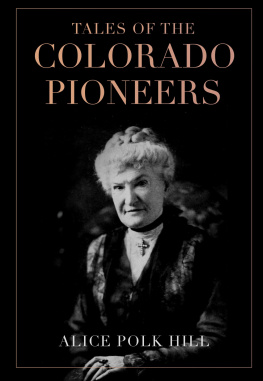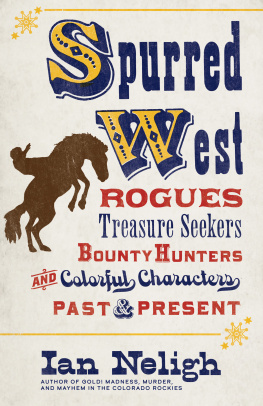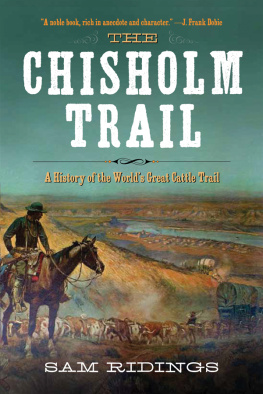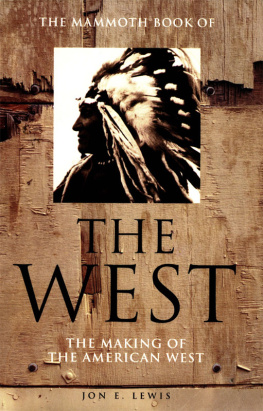Published by The History Press
Charleston, SC 29403
www.historypress.net
Copyright 2011 by Jolie Anderson Gallagher
All rights reserved
First published 2011
Second printing 2012
e-book edition 2013
Manufactured in the United States
ISBN 978.1.62584.201.5
Library of Congress Cataloging-in-Publication Data
Gallagher, Jolie.
A Wild West history of frontier Colorado : pioneers, gunslingers, and cattle kings on the eastern plains / Jolie Gallagher
p. cm.
Includes bibliographical references.
print edition ISBN 978-1-60949-195-6
1. Colorado--History--To 1876. 2. Frontier and pioneer life--Colorado. 3. Ranch life--Colorado--History--19th century. 4. Plains--Colorado--History--19th century. 5. Colorado--History, Local. 6. Colorado--Social life and customs--19th century. 7. Pioneers--Colorado--Biography. 8. Outlaws--Colorado--Biography. 9. Ranchers--Colorado--Biography. 10. Colorado--Biography. I. Title.
F780.G25 2011
978.801--dc23
2011037319
Notice: The information in this book is true and complete to the best of our knowledge. It is offered without guarantee on the part of the author or The History Press. The author and The History Press disclaim all liability in connection with the use of this book.
All rights reserved. No part of this book may be reproduced or transmitted in any form whatsoever without prior written permission from the publisher except in the case of brief quotations embodied in critical articles and reviews.
Acknowledgments
In a time when the tall tale was the prominent form of entertainment, pioneers often stretched the truth in biographies, retelling their stories with a wink of an eye and a foggy memory. Newspapers were no more reliable; their editors occasionally printed satires, rumors or skewed facts. But through all the yarn spinning and sketchy reporting, the trailblazers presented an astounding history of Colorados early days, where only the most rugged individual could survive hardships on the unsettled prairie. Drawing from their accounts, this book attempts to extract historical facts from the grand prevarications. It presents a true history of Colorados eastern frontierfrom the gold rush to the coming of the railroadwhile also preserving an old yarn or two.
I want to thank all the dedicated curators, librarians and museum volunteers who assisted me with research, including Sarah Everhart at History Colorado, Coi Drummond-Gehrig and Bruce Hanson at the Western History Department of the Denver Public Library, Snow Staples at the Overland Trail Museum, Mary McKinstry at the Fort Sedgwick Historical Society, Mary-Jo Miller at the Nebraska State Historical Society, Mary Wallace at the Pueblo County Historical Society, and Barbara Barbaro and Don Kallaus at the Old Colorado City Historical Society. I especially want to thank Carol Turner for reading my draft and offering her encouragement, Jeff Broome for answering my emails and Byron Hardwick for providing his expertise in antique firearms. And finally I must acknowledge my marvelously supportive husband, Sean Gallagher. He read my drafts, created maps, took photos and generally held down the fort while I wrote. Without him, this book would not have been possible.
Chapter 1
The Argonauts
Not every man stands over his own grave. But in 1859, Daniel Chessman Oakes pondered a rubbish-filled hole and mock headstone that bore his name: Here lie the remains of D.C. Oakes, Who was the starter of this damned hoax!
Scrawled on buffalo bones in mixtures of charcoal and axle grease, the chilling epitaph greeted Oakes and his business partners along a lonely stretch of trail. The sight not only alarmed Oakes, it also confused him. An experienced prospector at age thirty-four, he had spent the previous summer scouring the South Platte River and the surrounding tributaries near present-day Denver. While at the base of the mountains, Oakes met with early prospectors in the area, men like William Green Russell and his party from the mines of Georgia. Russell had discovered small quantities of placer gold on Little Dry Creek in 1858. It wasnt much, but it was no hoax either.
One member of the Russell party, Luke Tierney, had documented the finds in his personal journal and showed his notes to Oakes. Impressed with Tierneys account, Oakes persuaded the Georgia miner to let him use the notes as the basis for a gold-seekers guide. Oakes appended his own travel advice, returned to Iowa and secured businessman Stephen Smith as a publishing partner. Smith printed History of the Gold Discoveries on the South Platte River in the winter of 18581859 and distributed copies to outfitting stations in Missouri River towns.
Within weeks of its publication, the Smith & Oakes guide and others like it spawned the hopes of eighty thousand people, launching one of the greatest migrations in American history. To his credit, Oakes accurately described the barren landscape and adverse conditions, but that didnt stop would-be prospectors from embarking on a six-hundred-mile journey across dry and dangerous territory. Like the mythical Greek Argonauts seeking the Golden Fleece, desperate men crossed the plains through unknown perils, with no railroads, no stage coaches and poorly marked trails to guide them. Some rode comfortably in ox-drawn wagons, bearing optimistic slogans such as Pikes Peak or Bust, while others pulled handcarts or walked with packs over the bleak wilderness. All believed the journey would amply reward their efforts. They imagined riverbeds of riches waiting for them, some so hopeful that they brought empty flour sacks in anticipation of filling each one with gold. Yet when the exhausted pilgrims finally arrived at the confluence of the South Platte River and Cherry Creek, the novice gold seekers dug up nothing but rocks and sand. The furious masses turned back for home and, along the way, left effigies and graffiti to express their disgust at the gold promoters.
Below present-day Julesburg, Oakes stood over the mound the go-backers had left behind. His partners were as solemn as if they attended a real funeral. They told him, Oakes, that crowd has buried you here. That means murder if they ever meet up with you.
Pikes Peakers camping in the mountains. Courtesy Denver Public Library Western History Collection, X-21803.
In an unsettled, lawless territory, Oakes found himself on a collision course with thousands of prospectors, opportunists, gamblers and outlaws. And hoax or not, Colorados Wild West was born.
THE CLAIM JUMPERS
In the 1850s, Americans knew little about the far reaches of the plains. Maps of that decade referred to the terrain between the Missouri River and the Rocky Mountains as the Great American Desert or the Pikes Peak region. To city dwellers of the East, the western territories were vast and unexploredas alien as the moon. But to some adventurous spirits, the uncharted country presented an opportunity to seek their fortune.
In September 1858, several groups of Kansas businessmen packed for their first trip west. The businessmen heard rumors that the Russell party found gold in the Pikes Peak region (then part of Nebraska, Utah, New Mexico and Kansas territories). But they didnt intend to pan for gold themselves. Instead, they hoped to establish a town charter and sell tracts of land in the newly formed Arapahoe County, Kansas Territory, where Russell was prospecting. Before leaving, they met with the governor of the territory, James Denver. The governor selected county officers among the businessmen, giving them appointments such as commissioner, judge and sheriff, although the titles were meaningless. The land was established Indian territory where few white people had ventured.










